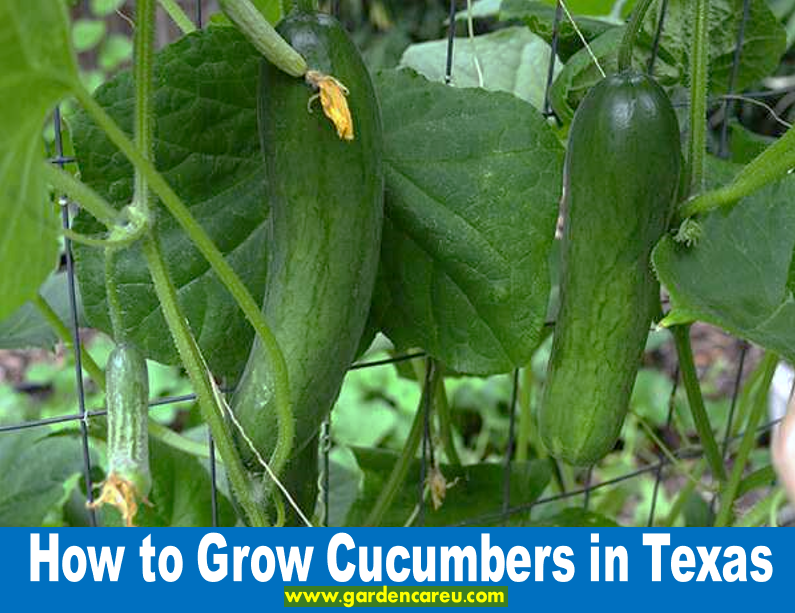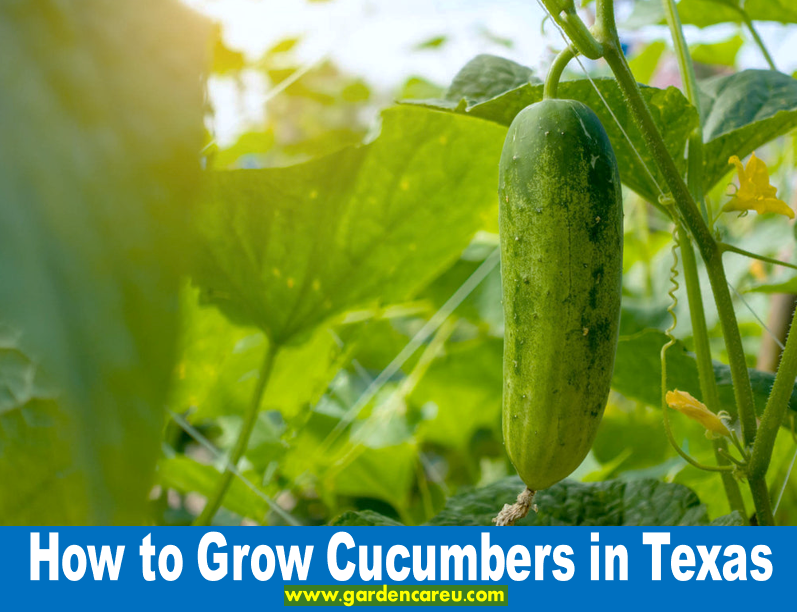How to Grow Cucumbers in Texas: To grow cucumbers in Texas, ensure sun exposure and warm, fertile soil. Start planting seeds outdoors in late March or April and again in August.
Cucumbers thrive in Texas’s sunny and warm climate, making it an ideal location for cultivation. The key to successful growth is providing the right conditions, such as well-drained, fertile soil and plenty of sunlight. Beginning your cucumber planting in late March through April or August ensures optimal growth.
Following these steps, you can enjoy a bountiful cucumber harvest in your Texas garden. Cucumbers are a versatile and rewarding crop for any Texan gardener, whether you grow them in a greenhouse or outdoors.

Selecting The Right Varieties
If you want to grow cucumbers in Texas, selecting the right varieties is crucial for a successful harvest. Texas’ climate and soil conditions can be challenging, so choosing cucumber types that thrive in this environment is important. This guide will help you determine the best varieties for Texas and understand the differences between slicer and pickling cucumbers.
Best Varieties For Texas
Regarding growing cucumbers in Texas, several varieties are well-suited to the state’s climate and soil. Some of the best cucumber varieties for Texas include:
- Armenian
- Bush Champion
- Burpless
- Marketmore
- Salad Bush
These varieties are known for their heat tolerance and disease resistance, making them ideal choices for Texas gardeners.
Slicer Vs. Pickling Cucumbers
When choosing cucumber varieties, it’s important to consider whether you want slicer or pickling cucumbers.
Slicer cucumbers, as the name suggests, are ideal for fresh eating. They are usually larger, with tender skins and juicy flesh. On the other hand, pickling cucumbers are smaller and firmer, making them perfect for pickling recipes.
While slicer cucumbers are great for salads and snacking, pickling cucumbers is essential to preserve your harvest through pickling and canning. Consider your culinary preferences and intended use when deciding between these two types of cucumbers.
Optimal Growing Conditions
To grow cucumbers in Texas, it is important to provide optimal growing conditions. This includes planting seeds outdoors in late March through April and again in August, ensuring they receive plenty of sun and warm, fertile soil. Additionally, it is recommended to feed the cucumber plants with a high nitrogen feed every two weeks for best results.
Optimal Growing Conditions for Cucumbers in Texas Sun and Warmth Requirements
Sun And Warmth Requirements
Cucumbers require abundant sunlight and warm temperatures to thrive in Texas.
Soil Type and Preparation
Soil Type And Preparation
Choosing the right soil type and preparing it adequately is crucial for successful cucumber growth.
Planting And Caring For Cucumbers
Growing cucumbers in Texas requires planting seeds outdoors in late March through April or again in August. Cucumbers thrive in sunny areas with fertile soil and need regular watering and a high nitrogen feed every two weeks for optimal growth.
Building a trellis for them to climb on can also help increase yields.
When To Plant Cucumbers In Texas
For successful cucumber growth in Texas, knowing when to plant them is important. Cucumbers thrive in the sun and warm, fertile soil. The ideal time to start planting cucumber seeds outdoors in Texas is late March through April. This ensures that the weather is warm enough for the plants to grow. You can also plant cucumbers again in August for a second harvest. By following these planting times, you can maximize your cucumber yield.
Tips For Watering And Feeding
To ensure your cucumber plants receive proper hydration and nutrients, here are some tips:
- Watering: Cucumber plants prefer moist but not wet soil. To maintain the right moisture level, it is best to water them a little and often.
- Feeding: Cucumber plants are heavy feeders and require regular nourishment. Feed them a high-nitrogen fertilizer every two weeks to provide the necessary nutrients for their growth.
- Sun and Shade: While cucumbers like the sun, they are prone to scorching. Providing them with some shade can help protect the plants from excessive sun exposure.
- Climbing Varieties: If you grow cucumbers in a greenhouse, encourage the plants to climb using trellises or other supports. This not only saves space but also boosts yields.
Following these watering and feeding tips ensures that your cucumber plants remain healthy and produce plentiful fruits.
Trellising Cucumbers For Success
Start of ‘Trellising Cucumbers for Success’ section Advantages of Letting Cucumbers Climb
Advantages Of Letting Cucumbers Climb
- Easier picking and harvesting
- Less susceptibility to diseases
Building a Trellis for Cucumbers
Building A Trellis For Cucumbers
One effective method of growing cucumbers in Texas is to let them climb a sturdy trellis. Building a trellis offers numerous benefits to both the plants and the gardener.
- Enhanced air circulation for healthier plants
- Saves garden space
- Reduced risk of pest infestation
When constructing a cucumber trellis, you can use wooden stakes, wire mesh, or even repurposed items like old ladders. Ensure the trellis is securely anchored to the ground for stability.
Common Challenges And Solutions
Growing cucumbers in Texas can be a rewarding endeavor, but it comes with its own challenges. Understanding and how to address these challenges can help ensure a successful cucumber harvest. Here, we’ll explore some common issues that Texas cucumber growers may encounter and provide practical solutions to overcome them.
Preventing Pest Damage
Cucumber plants are susceptible to pest infestations, such as cucumber beetles and aphids, especially in the warm Texas climate. These pests can cause significant damage to the plants, affecting their growth and productivity. To prevent pest damage, it is essential to implement proactive pest control measures, such as regularly inspecting the plants for signs of infestation and promptly removing any affected foliage. Natural pest deterrents like neem oil or planting companion plants that repel pests, such as marigolds, can help protect cucumber plants from destructive insects.
Dealing With Pollination Issues
Poor pollination can lead to malformed or underdeveloped cucumbers, affecting the overall yield of the plants. In Texas, high temperatures can sometimes hinder the natural pollination process, leading to pollination issues. To address this, hand pollination can be an effective solution. Gently transferring pollen from male to female cucumber flowers using a small brush or cotton swab can help ensure proper pollination and fruit development. Additionally, providing adequate shade during the hottest parts of the day can help create a more favorable environment for natural pollination, thereby minimizing pollination issues.
Harvesting And Enjoying Your Cucumbers
After planting and caring for your cucumber plants, it’s time to enjoy the fruits of your labor. Harvesting cucumbers at the right time and maximizing their yields can lead to an abundance of fresh, crunchy cucumbers for your kitchen.
Timeframe For Cucumber Fruit Production
Typically, cucumber plants begin to produce fruits around 50-70 days after planting. However, this timeframe can vary depending on the specific variety of cucumbers you are growing and the environmental conditions in Texas.
Maximizing Cucumber Yields
To ensure a bountiful harvest, here are some tips to maximize cucumber yields:
- Regularly check for ripe cucumbers, as they can grow quickly.
- Harvest cucumbers when firm, bright green, and around 6-8 inches long for optimal taste and texture.
- Remove any overripe or yellow cucumbers promptly to encourage ongoing fruit production.
- If growing vining cucumbers, provide proper support to help the plants thrive and produce more fruit.

Frequently Asked Questions Of How To Grow Cucumbers In Texas
When Should You Plant Cucumbers In Texas?
Plant cucumbers in Texas from late March to April and again in August for optimal growth. Cucumbers thrive in sunny, warm, and fertile soil conditions, which is essential for successful cultivation.
What Is The Trick To Growing Cucumbers?
Plant in the sun and warm, fertile soil to grow cucumbers successfully. Keep the soil moist but not wet, and feed with high nitrogen every two weeks. Provide some shade to prevent scorching and encourage climbing for better yields. Trellised cucumbers are easier to pick and less prone to disease.
Is It Better For Cucumbers To Grow Up Or On The Ground?
Cucumbers thrive when they can climb instead of spreading on the ground. Trellised cucumbers are easier to pick and less susceptible to diseases.
How Long Does It Take For A Cucumber Plant To Produce Fruit?
A cucumber plant typically takes about 50-70 days to produce fruit.
What Is The Best Time To Plant Cucumbers In Texas?
The best time to plant cucumbers in Texas is late March through April and again in August.
How Can I Optimize Cucumber Growth In Texas?
To optimize cucumber growth in Texas, provide sun and warm, fertile soil, water them regularly, and feed with high nitrogen fertilizer every two weeks.
Conclusion
Growing cucumbers in Texas is a rewarding experience. By following the right techniques and care tips, your cucumber plants are set to thrive. Remember the importance of sunlight, soil quality, and proper watering. With a little patience and dedication, a bountiful cucumber harvest awaits you.
Happy gardening!


